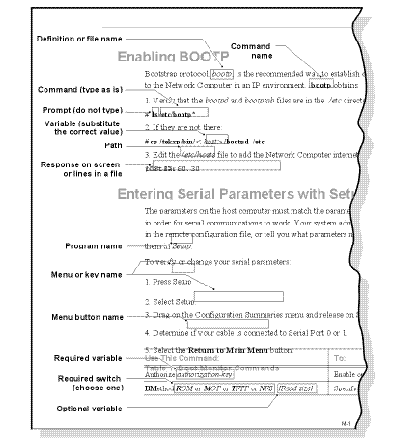Introduction
With the Tek3270 and Tek3179G terminal emulators, you can open fully functional 3270 or 3179G windows on your network computer. You can use these windows to log on to SNA and TCP/IP mainframe operating systems and run the application programs from your network computer. The windows have all the features and functionality you need to run your IBM applications.
The Tek3287 printer emulator provides screen printing from your network computer to a local printer. Information on setting up a print spooler is in Appendix A, Printing, of the Network Computer Reference manual.
NOTE: You may want to read the Network Computer User manual for information on how to operate your network computer.
Audience
This manual assumes:
-
You are familiar with: IBM 3270, 3278, 3279, or 3179G Information Display Station functionality
-
You know how to operate your network computer
-
You know how to log on to a host on your network
-
You know how to run your host applications
Product Features
You can use your network computer to perform standard IBM 3270 text operations (in a 3270 window) or graphical operations (in a 3179G window). There are a number of keyboards available for your network computer. If your network computer does not have a 3270 style keyboard, you can use keystroke sequences to access the 3270 key functions.
NOTE: Tek3179G includes all of the Tek3270 features.
Tek3270 Features
-
TN3270 protocol support
-
Models 2, 3, 4, and 5 emulation
-
Full seven-color support
-
Function keys
-
Dynamic font resizing
-
Keyboard mapping
-
Operator information area
-
Cursor movement keys
-
Extended attributes
Tek3179G Features
-
Full Tek3270 product features
-
Models 2, 3, 4, and 5 emulation
-
GDDM mouse
-
Support for a wide variety of IBM host graphics applications
-
Support for area fill, markers, patterns, and programmed symbol sets
-
Support for image data
NOTE:
Tek3179G does not support Underpaint Mix Mode.
Terminology and Conventions
Basic operating information about your network computer, including mouse and keyboard information is included in the Network Computer User manual.
This symbol indicates a Launcher Menu selection. Depending on how your account is set up, the Launcher may already be on your screen. If that is the case, simply use the mouse to select an option. If the Launcher is not present, press the Setup key on the keyboard. For 101/102 with Pause key keyboards, press and hold the Shift key and then press Setup to access the
Setup
window. For UNIX keyboards press the key sequence: AltGraph-Setup to access the Launcher. For 3270 keyboards use Alt-Setup.
Alt key Hold Alt while pressing other keys in a sequence
Ctrl key Hold Ctrl while pressing other keys in a sequence
Esc key Press and release Esc then press other keys in a sequence
Button (mouse) The three buttons on the top of the mouse. See Mouse Button Configuration. shows the factory configuration of the buttons.
Mouse Button Configuration.
Button Name in Manual
|
3-button Mouse Selection
|
|
Select
|
Left button
|
|
Menu
|
Middle button
|
|
Custom
|
Right button
|
Clicking Quickly pressing and releasing the mouse button without moving the pointer.
Dragging Pressing and holding the mouse button while moving the pointer.
Moving Changing the location of the pointer on the screen by moving the mouse.
Pointer An arrow on the screen indicating the current cursor position for selecting or clicking.
Pointing Positioning the pointer on an object on the display by moving the mouse.
See Typographical Conventions. illustrates the typographical conventions used in this manual.
Related Documentation
The following manuals are available in hard copy:
-
NCBridge Installation for UNIX
Environments -- 9300845
NCBridge Installation for VMS
Environments -- 9300846
NCBridge Installation for Windows NT
Environments -- 9300847
Explains how to install a network computer in the specified environment.
-
Serial Xpress User -- 9300834
Provides information about Serial Xpress, where you use a serial cable instead of a network cable to connect your network computer with a remote host.
The following manuals are available on the
Documentation CD-ROM
:
Provides basic operating information about your network computer.
-
Network Computer Reference
Provides reference information about network computers, including remote configuration, Setup, and the Boot Monitor.
Provides operating information for the 3270/3179G terminal emulator.
Provides operating information for the 3270/3179G terminal emulator.
If your site uses an OpenConnect Server, you may wish to refer to the OpenConnect documentation for specialized server options.
The following documentation is available in local bookstores:
-
X Window System User's Guide
-- O'Reilly & Associates, Inc.
ISBN 0-937175-29-3
Presents window system concepts and includes tutorials for many clients.

